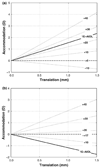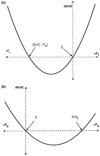Evaluation of the performance of accommodating IOLs using a paraxial optics analysis
- PMID: 20444117
- PMCID: PMC3065361
- DOI: 10.1111/j.1475-1313.2009.00694.x
Evaluation of the performance of accommodating IOLs using a paraxial optics analysis
Abstract
Purpose: We employed an analytical approach to evaluate the key parameters for the potential design optimisation of accommodating intra-ocular lenses (AIOL) and to use these parameters to predict their accommodative performance.
Methods: Paraxial thin-lens equations to predict the accommodative performances of single-element (1E) and two-element (2E) AIOLs were developed. 2E-AIOLs with either mobile front or back lens elements were analysed as well as 1E-AIOL for their accommodative performance. A paraxial model including key ocular components (corneal surfaces, pupil and retina) as well as AIOL was used to evaluate the key control parameters and optimal design configurations. A range of variants of the model, representing varying powers of front and back optical elements and with either front or back optical element mobile was tested.
Results: Optimal accommodative performance of 2E-AIOL is governed by the power combinations of its optical elements; design variants with higher positive front element power produced greater accommodative efficacy, while mobility of the front element contributed more to the accommodative performance than the back element. The performance of 1E-AIOL is primarily governed by the power of the AIOL; the higher the AIOL power, the better the accommodative performance.
Conclusions: From an accommodative performance standpoint, the optimal design of 2E-AIOL should comprise a high plus power front element. Considering the maximum potential amounts of element translation available clinically, 2E-AIOLs are predicted to offer higher accommodative performance compared to 1E-AIOL.
Figures



Similar articles
-
Paraxial analysis of the depth of field of a pseudophakic eye with accommodating intraocular lens.Optom Vis Sci. 2011 Jul;88(7):789-94. doi: 10.1097/OPX.0b013e318219c155. Optom Vis Sci. 2011. PMID: 21516047 Free PMC article.
-
Magnifications of single and dual element accommodative intraocular lenses: paraxial optics analysis.Ophthalmic Physiol Opt. 2011 Jan;31(1):7-16. doi: 10.1111/j.1475-1313.2010.00795.x. Epub 2010 Nov 4. Ophthalmic Physiol Opt. 2011. PMID: 21054469 Free PMC article.
-
Predicting the performance of accommodating intraocular lenses using ray tracing.J Cataract Refract Surg. 2006 Jan;32(1):129-36. doi: 10.1016/j.jcrs.2005.07.047. J Cataract Refract Surg. 2006. PMID: 16516791
-
Accommodating intraocular lenses: a critical review of present and future concepts.Graefes Arch Clin Exp Ophthalmol. 2007 Apr;245(4):473-89. doi: 10.1007/s00417-006-0391-6. Epub 2006 Aug 30. Graefes Arch Clin Exp Ophthalmol. 2007. PMID: 16944188 Review.
-
Benefits and barriers of accommodating intraocular lenses.Curr Opin Ophthalmol. 2017 Jan;28(1):3-8. doi: 10.1097/ICU.0000000000000323. Curr Opin Ophthalmol. 2017. PMID: 27653608 Review.
Cited by
-
Paraxial analysis of the depth of field of a pseudophakic eye with accommodating intraocular lens.Optom Vis Sci. 2011 Jul;88(7):789-94. doi: 10.1097/OPX.0b013e318219c155. Optom Vis Sci. 2011. PMID: 21516047 Free PMC article.
-
Clinical application of accommodating intraocular lens.Int J Ophthalmol. 2018 Jun 18;11(6):1028-1037. doi: 10.18240/ijo.2018.06.22. eCollection 2018. Int J Ophthalmol. 2018. PMID: 29977819 Free PMC article. Review.
-
Axial movement of the dual-optic accommodating intraocular lens for the correction of the presbyopia: optical performance and clinical outcomes.J Optom. 2015 Apr-Jun;8(2):67-76. doi: 10.1016/j.optom.2014.06.004. Epub 2014 Sep 22. J Optom. 2015. PMID: 25248803 Free PMC article. Review.
-
Magnifications of single and dual element accommodative intraocular lenses: paraxial optics analysis.Ophthalmic Physiol Opt. 2011 Jan;31(1):7-16. doi: 10.1111/j.1475-1313.2010.00795.x. Epub 2010 Nov 4. Ophthalmic Physiol Opt. 2011. PMID: 21054469 Free PMC article.
References
-
- Artal P, Marcos S, Navarro R, Miranda I, Ferro M. Through focus image quality of eyes implanted with monofocal and multifocal intraocular lenses. Optical Engineering. 1995;34:8.
-
- Assia EI. Accommodative intraocular lens: a challenge for future development. J. Cataract Refract. Surg. 1997;23:458–460. - PubMed
-
- Auffarth G, Martin M, Fuchs H, Rabsilber T, Becker K, Schmack I. Validitat der Vorderkammertiefenmessung zur akkommodationsevaluierung nach implantation einer akkommodativen intraokularlinse (Modell Humanoptics 1CU) Ophthalmologe. 2002a;99:815–819. - PubMed
-
- Auffarth G, Schmidbauer J, Becker K, Rabsilber T, Apple D. Miyake-Apple-Video-Analyse des Bewegungsmusters einer akkommodativen intraokularlinse. Ophthalmologe. 2002b;99:811–814. - PubMed
-
- Bakaraju RC, Ehrmann K, Papas E, Ho A. Finite schematic eye models and their accuracy to in-vivo data. Vision Res. 2008;48:1681–1694. - PubMed
Publication types
MeSH terms
Grants and funding
LinkOut - more resources
Full Text Sources
Molecular Biology Databases

